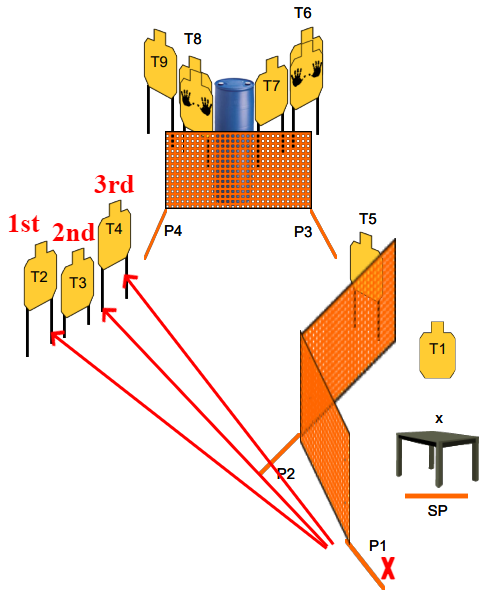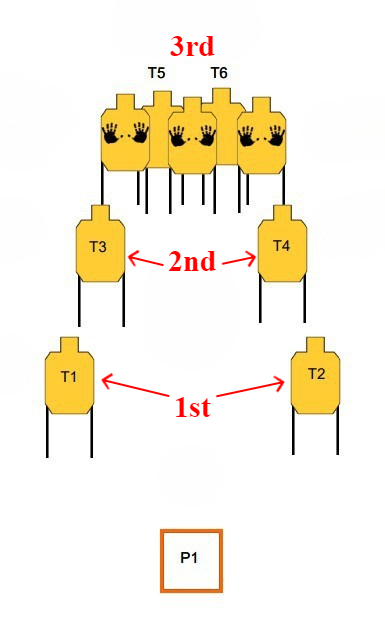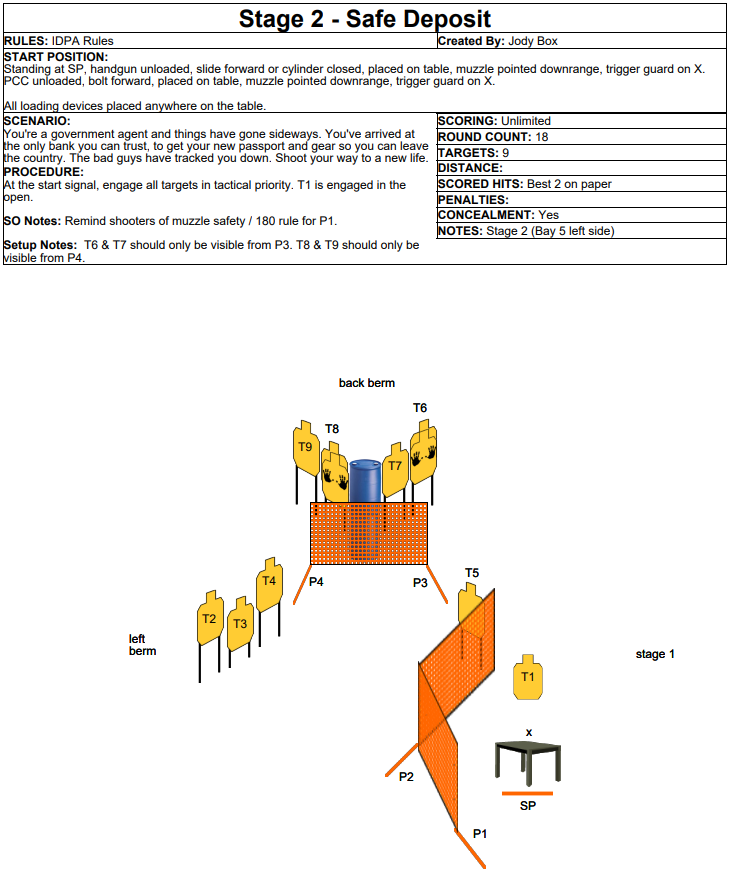Welcome back to our in-depth look into IDPA. We have already covered what IDPA is, basic rules and guidelines, and equipment. Now we will discuss scoring and tactical priority in IDPA. Check out Part III where we cover divisions and classifications.
Scoring
IDPA uses a “time plus” scoring method, meaning your score is simply your raw time to complete the stage, plus any time penalties from target scoring or procedural penalties (i.e., leaving a loaded magazine on the ground after reloading, shooting beyond a fault line, etc.). So, everyone’s score is given as a time, seconds measured down to the hundredth. At the end of a match, all scores for each stage are added to get each competitor’s final aggregate score. The lowest score wins. It’s like golf for men.

The IDPA target has three scoring zones, -0, -1, and -3. Hits in each zone will add their respective time to your score. Stages typically require two hits per target and thus only score the best two hits on each target. So, two shots in the -0 will add nothing to your score, while a hit in the -1 and one in the -3 would add 4 seconds to your stage score. In IDPA, 4 seconds can easily move you several spots in the rankings. On "unlimited" scoring stages, you may fire a makeup shot if you call a hit in the -1 or -3, more on that below. Shots landing on the perforated line between scoring zones are given the better score.
The below target is called a "non-threat" and will incur a 5 second penalty when hit. A quick note on targets in depth and shoot throughs. IDPA rules allow for "shoot through", meaning a shot on a threat target which passes through and strikes a non-threat will be scored, but will still incur the 5-second non-threat penalty. The reverse is also true. Threats and non-threats will often overlap each other giving you only partial exposure to safely engage the threat target.

During the stage brief you may hear Unlimited and Limited scoring. All this means is whether you are allowed to fire extra shots or not. During Limited stages, you may only fire the prescribed number of rounds at each target. Extra shots will get you a procedural penalty. Get your -0 hits, just do it quickly.
Tactical Priority
This is where you may need to bear with me. Tactical priority can be confusing to new IDPA shooters and annoying even to experienced ones. To keep it brief, I will quote the IDPA rulebook section 3.2.1:
- All targets must be engaged in tactical priority, including all targets engaged “in the open.”
- Targets are considered equal threat when the difference in the target distances to the shooter is less than 2 yards.
- If several targets are visible at the same time, targets are engaged from near-to-far unless they are equal threat.
- If targets are hidden by vertical cover, the targets are engaged as they become visible around the edge of cover.
Using the figures below as examples, we will briefly describe the engagement order of the targets.
Vertical Cover

Vertical cover is show in the figure above, a wall with a fault line at the end of it (the orange line at P1/Position 1). At the start of the stage, the shooter would engage Target 1 (T1) at the Start Position (SP) immediately as it is nearest and in the open. The shooter would then move to P1 and engage the targets “as they become visible around the edge of cover” meaning, in this case, from left to right; T2, T3, and finally T4. Many of you may be familiar with this concept as "slicing the pie". Once the targets have been engaged with the required number of rounds per the stage brief, the shooter may then move to other positions and shoot targets without penalty.

Targets in the Open
Now, with no fault lines or cover in play, these targets shown above are considered in the open. Per IDPA rules, tactical priority says the nearest targets will be engaged first with the required number of rounds per target. In this scenario, the shooter would shoot T1 and T2 in any order from P1, then engage T3 and T4, and so on. Note the non-threat targets partially obscuring T5 and T6.
A single stage may have a mix of vertical cover and open targets. Open, or “surprise” targets should be designated as such in the stage brief and setup notes. If you have questions, feel free to send them my way or if you are at a match with questions, ask the Safety Officer running that stage.
Stage Brief
Now that we have covered just enough to get you to run a stage safely without a DQ, let’s look at an example of a full stage brief. This one is borrowed from my local club.

The stage brief will give you all the information you need to complete that stage. It gives the starting position, procedure, round count, scoring method, number of targets, concealment, and other information. As we can see in the above example, this stage uses unlimited scoring and consists of 9 IDPA targets with two shots per target required for engagement for a total of 18 rounds fired. Concealment is required.
Start position is at SP with the handgun unloaded, slide forward and placed on the table with the muzzle downrange and trigger guard on the X. All magazines are on the table. At the start signal, the competitor will retrieve and load their weapon and engage all targets using tactical priority. Tactical priority tells us we will begin with T1 in the open before moving to P1 to engage T2-4 from behind cover, and so on moving from position to position engaging all targets until complete. Other setup notes and the stage scenario are given, but these typically do not describe how the shooter will conduct the stage.
And that's Part II. If you have any questions or comments, feel free to reach out to me directly. Again, this is an introduction and doesn't get into detail on stage planning.
Current IDPA rules (as of this writing) are available at the links below.
IDPA Rulebook: https://www.idpa.com/wp-content/uploads/2023/12/2024-IDPA-Rulebook-Master-12-14-23.pdf
IDPA Equipment Appendices: https://www.idpa.com/wp-content/uploads/2023/03/2023_Equipment_Appendix_Master_v2.pdf
Match Administration Rules: https://www.idpa.com/wp-content/uploads/2023/01/2023-Match-Administration-Rules-V1.0-Master-01-04-2023.pdf
